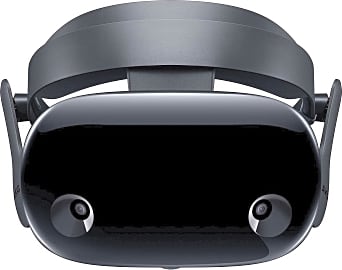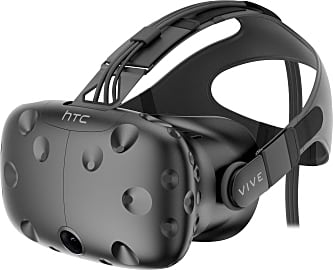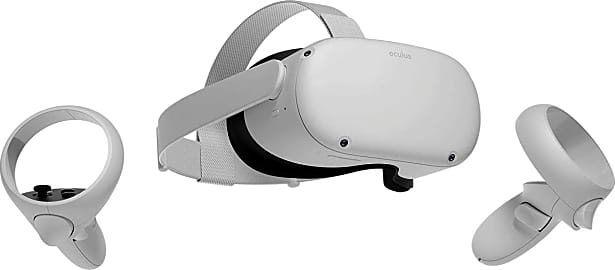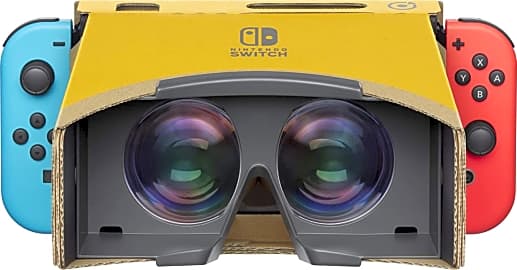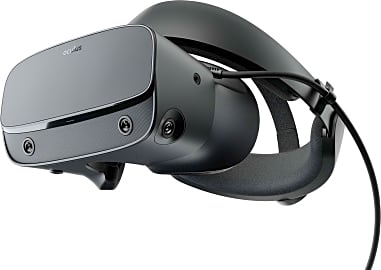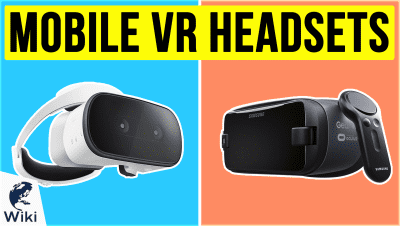The 10 Best VR Glasses

This wiki has been updated 38 times since it was first published in September of 2015. Immerse yourself more fully in movies, video games, and apps with a pair of these VR glasses. As display and sensor technology has increased over the past few years, quality headsets now deliver stunning visual experiences, and more and more apps and games are available every day. We've included models intended for dedicated gamers, those new to virtual reality, and commercial users. When users buy our independently chosen editorial picks, we may earn commissions to help fund the Wiki.
Editor's Notes
November 27, 2020:
Briefly, we'd like to address a significant change to one of the VR headset ecosystems that's occurred in the last few months.
As of October of 2020, all Oculus products must be linked to a Facebook account. The claimed reason for this is to allow administrators to moderate online communities and keep them safe and friendly for all. Many technology, media, and social policy experts, however, have offered quite a bit of outcry over this policy. One claim is that the advanced development and high-powered hardware of the Oculus Rift S and Quest 2 are partially subsidized by the massive data-hoarding industry of which Facebook is a part. While that may or may not be the case, the worrisome part of the Facebook account requirement is that Facebook, its moderation, and potential account access issues are often handled by algorithms or automation. After just a few months of the account linking requirement, consumers have been locked out of their accounts, and therefore their expensive headsets, for little to no reason.
Many analysts view this practice as unethical and anti-consumer, and for this reason, we've moved the Oculus products down quite a bit in our ranking. Also, for what it's worth, Facebook plans on discontinuing the Rift S in several months.
November 23, 2020:
The world of virtual reality is an exciting place right now. Constant innovations and competition are creating newer, better hardware, and the VR landscape is continually evolving to better accommodate users and their experiences. Some of the items on this list, such as the Oculus Go, HTC Vive Pro Eye System, and the HTC Vive Original are still available to purchase but have been discontinued by the manufacturer. They are still capable systems that fulfill certain user needs but will continue to be phased out and replaced by newer iterations such as the Oculus Quest 2 and HTC Vive Cosmos.
The recent releases of the PlayStation 5 and Xbox Series X, will likely bring a new generation of console-specific VR devices that can better make use of the capabilities of the new systems. Pardon the pun here, but make sure to keep your eyes open on this growing and changing market. We will be sure to keep you updated as to our opinions on the best gear for your VR needs.
For this update, we have replaced the Oculus Quest with its upgraded version, the Oculus Quest 2. The Oculus Quest 2 surpasses its predecessor's performance and improves on its features in almost every way. It has an increase in more pixels per eye, a lighter weight, and offers more storage capacity and RAM memory. One thing to be aware of, at the time of this writing, it does require that you have an active Facebook account that you'll need to log into in order to operate it.
We've also updated the listing for the Nintendo Labo Kit and the Sony PlayStation VR. The ranking order has been revised to reflect these changes, and we've added a new Special Honor that you might be interested in checking out.
November 07, 2019:
There's a lot going on with VR these days. While we wouldn't say that smartphone VR is completely dead, it has fallen considerably by the wayside. Nonetheless, there are several worthwhile accessories that can turn your smartphone into a VR headset, and the Merge Goggles are among the best.
There's also been an influx of standalone VR units recently. The Oculus Quest and Oculus Go are by far the two most important such developments; in fact, for a lot of users, the Quest is the easiest and most affordable choice, and it offers tons of fun for not just the owner, but also family and friends, due to its portability and user-friendly nature.
If you're dedicated to PC gaming, there are a few different considerations, not least of which is that you'll need relatively powerful hardware to drive a modern headset to its full potential. In that category, it's almost impossible to top the new HTC Vive Cosmos; rather than in-room sensors, it uses integrated cameras to provide premium motion tracking, and its display screens are about as good-looking as they come. With that said, the HTC Vive Original, the updated Oculus Rift S, and the ever-present Sony PlayStation VR also promise to provide many, many hours of interactive entertainment.
There are two more important systems worth mention, as well. Windows Mixed Reality is an up-and-coming ecosystem, and the Samsung Odyssey+ is frequently lauded as the best of the bunch there. Unlike many others, it uses an active-matrix OLED screen, whose dark blacks and bright colors lead to an especially immersive experience. And then there's the HTC Vive Pro Eye System, which costs an arm and a leg, but includes everything needed to provide essentially the most advanced VR yet developed. It's not, however, marketed towards home consumers, and is mostly used by professionals who demand the highest performance and have massive expense accounts to justify the investment.
Special Honors
Valve Index The Valve Corporation is a company that is widely known for its digital distribution service named "Steam". They are also the creators of several critically acclaimed computer games, such as the "Half-Life" series and its sequels. They've been in the business of providing video games and related software since the internet began to see widespread usage. Somewhat recently, the company has begun manufacturing and selling its own hardware devices, creating controllers designed to work with their online gaming platform. Their first attempt at a virtual reality headset is called the Valve Index. It has been highly praised as a device that brings together the very best of VR functionality and hardware capability. The Index is only available directly from Valve and is offered in several different configurations. It is sold as a complete kit, or you can purchase various combinations of controllers or elements if you already have other compatible components. Due to its popularity, there has been a waitlist for interested customers since its release. If it's within your budget range and you have the patience to wait a few weeks, the Index is one of the most powerful and capable VR systems manufactured today. valveindex.com
What Is Virtual Reality
The more senses which can be introduced artificially, the easier it is for the user to become immersed in the virtual world.
The term virtual reality refers to the creation of an artificial environment which is presented to the user in a fully immersive manner. The key to believable virtual reality is to block out the sensory input from the real world and recreate as many of these sensory inputs through the virtual world. The more senses which can be introduced artificially, the easier it is for the user to become immersed in the virtual world. For example, a VR system that utilizes eye goggles and earphones, is more effective than one which only makes use of eye goggles. Adding another sensory element such as a wind gust from a fan or a slight misting when the user is experiencing a boat ride in the virtual world makes it even more immersive and believable.
Some newer VR systems make use of special gloves and body suits which can apply pressure or vibrations at precise moments. If your virtual incarnation experiences an impact, you will feel a sudden startling vibration. In addition to helping provide a multi-sensory experience, these gloves and body suits aid in tracking the user's movements and actions so they can be appropriately applied to the virtual world.
The concept of virtual reality is simple, but the execution has proved considerably more difficult. VR systems have been in the works since the early 1980s, but have failed to capture the user in a truly immersive experience, or proved too costly for the home user. The advent of newer technologies has allowed the creation of immersive, cost-effective systems, which are finally emerging into the consumer marketplace.
History Of Virtual Reality
While the use of home virtual reality systems is a relatively recent development, the concept of virtual reality dates all the way back to a 1935 short story named "Pygmalion's Spectacles" by Stanley G. Weinbaum. In it, the author describes a VR system that makes use of goggles and a holographic recording system.
The first immersive, multi-sensory VR system was created in the 1960s by Morton Hellig. It was called the Sensorama and made use of a wraparound screen viewed through a binocular-like device to display a stereoscopic 3-D image. It also had a moving seat and vents to direct short bursts of air at the viewer as they watched films.
In the last few years, new technology has made home VR systems affordable and increasingly realistic with devices like the Oculus Rift and Sony's Project Morpheus.
From the 1960s to the 1990s, there were a few other notable VR systems that are worth mentioning. In 1968, Ivan Sutherland and Bob Sproull invented the first head-mounted VR system. It was so heavy that it actually had to be suspended from the ceiling and the primitive graphics were simple wire-frame models. In 1978, MIT students developed the Aspen Movie Map. It was a virtual simulation of Aspen, Colorado that allowed the user to walk the streets. The user could choose from a summer or winter scene, which were both based on actual photographs or a polygon mode, which was a basic 3-D model of the city.
In the 1980s, Atari toyed with virtual reality and opened a dedicated lab focused on experimenting with the concept. Unfortunately, it closed just two years later during the video game crash of 1983.
Virtual reality experienced renewed public interest in the 1990s from movies like Johnny Mnemonic, Virtuosity, and the Lawnmower man. This led to a surge in companies working on the development of the technology. Sega, Apple, and Nintendo all jumped on the bandwagon alongside many lesser known names like Electronic Visualization Laboratory and Forte Technologies. All of the devices released were relatively expensive and none had staying power as they all disappeared from the marketplace quickly. In the last few years, new technology has made home VR systems affordable and increasingly realistic with devices like the Oculus Rift and Sony's Project Morpheus.
How Virtual Reality Glasses Work
The two most basic components needed for a VR system to function are a display and some kind of input. In budget virtual reality glasses, the display is often your smartphone, while the higher end models have integrated display screens inside of the head-mounted unit. The inputs can range from head and eye tracking devices to hand controllers.
If using a model with integrated display screens, the video is sent to the device via an HDMI cable.
If using a model with integrated display screens, the video is sent to the device via an HDMI cable. The better systems use two display screens and two feeds. They will also have a lens placed between your eyes and the screen that is designed to slightly angle and reshape the 2D images, recreating the natural variations in how your two eyes see the world.
For virtual reality glasses to be truly effective, they must track your movements in some way. They can utilize eye tracking, head tracking, or motion tracking. The most basic systems will utilize one tracking method, while the more expensive models will track all three.
Head tracking allows VR glasses to display an image that moves as you tilt your head. This plots the pitch, yaw, and roll of your head on the X, Y and Z axes using the six degrees of freedom system.
Motion tracking allows the movements of your body and hands or a controller to be recorded so your virtual incarnation can perform similar actions. Eye tracking makes depth of field more realistic. This brings items that you are looking directly at into pinpoint focus, while peripheral objects will be slightly out of focus, just like real life.



